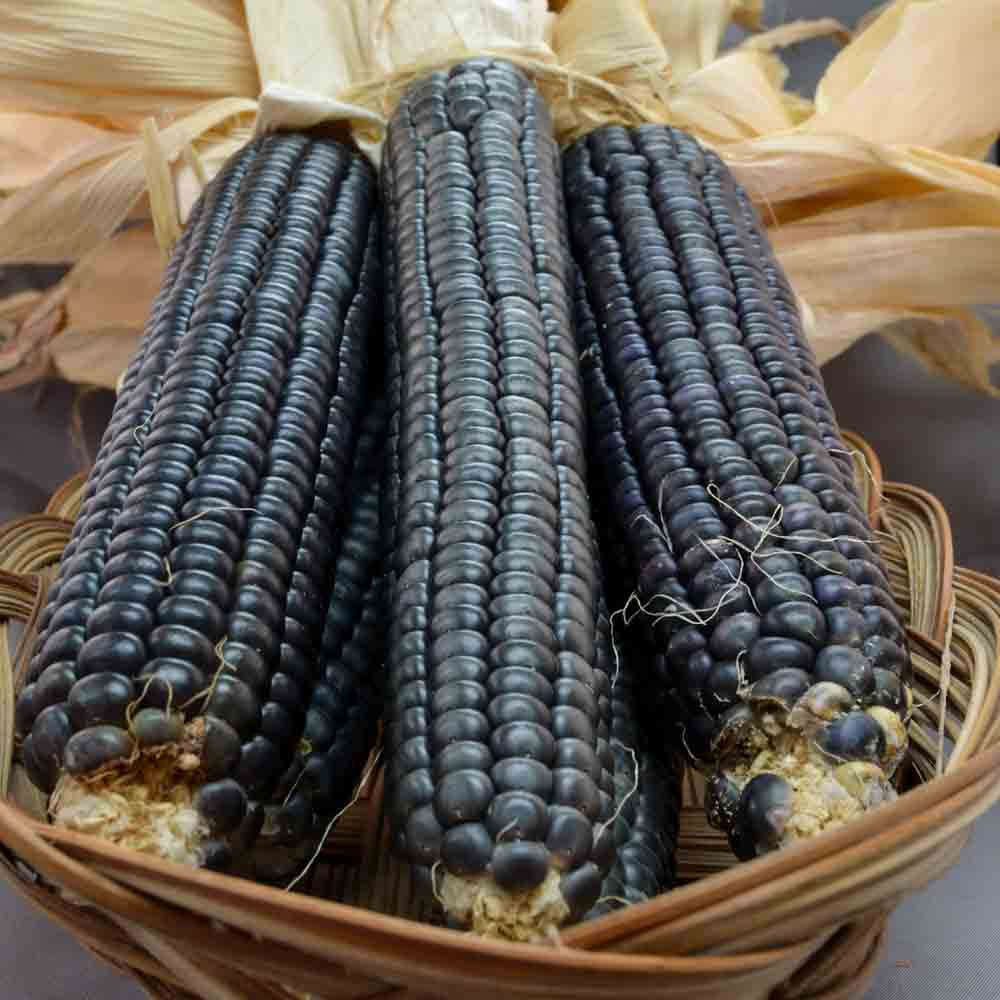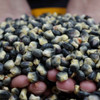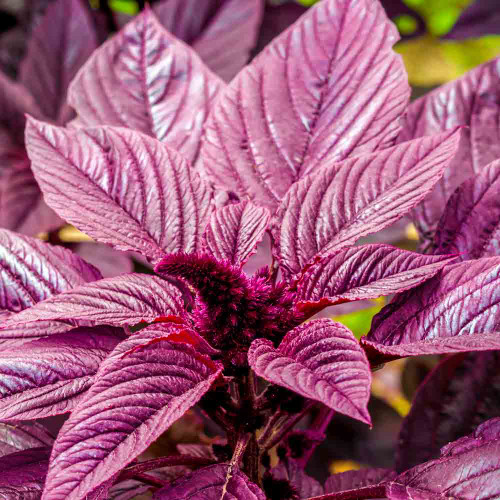Description
Hopi Blue Corn - Flavor That Redefines Corn
There are garden moments that become new benchmarks for flavor, discoveries so profound they can make you taste something familiar as if for the very first time, entirely redefining an ingredient. For us, Hopi Blue Corn did precisely that, first revealing its magic through its exceptional cornmeal. For over twenty years, Cindy has made blue corn flapjacks using a treasured recipe from Hell's Backbone Grill, and her blue corn cornbread consistently reveals a rich, nutty depth followed by a slight sweetness that makes even the best yellow cornmeal taste surprisingly bland by comparison – much like the difference between a true garden-grown tomato and its store-bought counterpart.
Then, roasting fresh, milk-stage ears of Hopi Blue Corn in their husks directly on a charcoal grill was another such revelation for us. The deep, rich aroma as the husks charred was intoxicating, but the first bite of those intensely flavored, sweet kernels was transformative.
This ancient heirloom, nurtured for millennia by the Hopi people, isn't just about history; it's about experiencing the true, remarkable depth of corn flavor.
Details
For the Hopi people of Northern Arizona, the ancient, open-pollinated Hopi Blue Corn holds a central place in their traditions and daily life; all family activities often revolve around its cycle, beginning with spring planting ceremonies. This corn is a very robust, drought-tolerant variety selected over many generations, well-adapted for harsh climates. Plants are often short, traditionally 4-5 feet tall in dry-farmed conditions, developing a bushy habit with side shoots (tillers) at the base that help prevent lodging (falling over) in wind. However, as an open-pollinated heirloom with a diverse genetic heritage, the final height of Hopi Blue Corn can vary significantly. Plants grown with more consistent water and soil fertility in a home garden, may readily reach 5-7 feet, or occasionally even taller. The pollen-producing tassels and sometimes stalks/leaves exhibit a striking reddish-purple color.
Each stalk bears separate male flowers (the tassel at the top) and female flowers (the ears, lower down, with silks). Wind pollination is essential for good kernel development, requiring it to be planted in blocks. Ears are typically 8-10 inches long, with plants commonly producing two per stalk. Kernels begin as ivory-colored in their milk stage, then, as they mature and dry, develop their stunning royal blue to blue-black luster. Historical Hopi classifications recognize distinct varieties based on these shades: standard blue (sakwaqa'o), hard blue (huruskwapu), and gray-blue (maasiqa'o).
Hopi Blue Corn is grown as a warm-season annual across a wide range of USDA Zones (typically 2-11), with maturity for dry grain generally around 70-110+ days. It is renowned for its ability to survive and produce in arid environments, a trait honed over centuries, attributed to deep root systems and the ability of seedlings to emerge from deep plantings in sandy soils.
History
Corn (maize) was first domesticated about 9,000 years ago in Mexico from the wild grass teosinte, arriving in what is now the Southwestern United States around 4,000 years ago. The Hopi people’s origin stories tell of Màasaw, the Guardian Spirit, who offered the clans several gifts – wood for the Hopi planting stick, a bag of seed corn, a gourd of water, and a small ear of blue corn. At Màasaw’s direction, the clans began an extended migration, learning on the way to cultivate corn and a better life embracing unity, selflessness, cooperation, and harmony with nature. Through millennia of continuous planting, close observation, and careful selection, the Hopi people became masters of dry-land farming, adapting corn to thrive in the region's harsh high, dry elevations and short, unpredictable growing seasons. Their traditional planting methods reflect this deep understanding; for instance, Hopi farmers would often plant 8-12 seeds in widely spaced mounds, using a digging stick to create holes about 12 inches deep in sandy soil to reach residual moisture. The sand was then replaced to act as a mulch. This deep planting is a key adaptation, helping seedlings send a single, strong root down to find life-sustaining water.
For the Hopi, corn, particularly blue corn, is a sacred element central to their cosmology, ceremonies, and identity, symbolizing their covenant with the land. It is present at every stage of life, from the first food after birth to the cornmeal sending them to the spiritual world upon passing. Different colors of corn hold deep symbolic meanings, with blue corn representing the Southwest. Within their matrilineal clans, Hopi women traditionally hold significant responsibilities in agriculture. It is often the women who check the corn stocks after winter, make crucial decisions about which colors and quantities to plant for the coming year, and meticulously prepare and bless the seeds to encourage a good harvest. This reverence and careful stewardship extend through the harvest, where traditionally, men bring in the corn, and women then prepare it for drying—stripping the husks and stringing the ears. From this harvest, a few perfect ears are meticulously saved for ceremonial use, while some of the best from the remainder are set aside as seed stock, ensuring the continuation of this vital corn lineage for future generations.
Uses
While it can be eaten as sweet corn when picked young (milk stage), offering a flavor that is less sweet but possesses a more intense, full corn flavor and a firmer texture than modern hybrid sweet corn varieties, Hopi Blue Corn is best known and traditionally used for making an excellent blue corn flour or meal. This meal, often reputed to have higher protein levels than common dent corns, possesses a distinctive nutty, earthy taste. It's famously used to make piki (a paper-thin Hopi bread often made with culinary ash), as well as tortillas, atole (a corn-based beverage or porridge), and various types of cornbread and corn chips. Enjoying these traditional preparations from homegrown Hopi Blue is often a deeply satisfying experience.
Roasting the young ears whole in the husk over a charcoal fire or grille gives the best flavor, as the sugars are caramelized and the flavor deepens with the roasting. When the outer parts of the husk are charred, the corn is roasted and ready to shuck. Set aside to cool for a couple of minutes, then peel the charred husk back to eat it.
The stunning silvery blue-black dried ears also make wonderful fall decorations.
Companion Planting
Hopi Blue Corn is a cornerstone of the traditional "Three Sisters" polyculture. In this system, the corn provides a natural trellis for pole beans to climb; the beans, as legumes, fix atmospheric nitrogen, benefiting all three plants; and sprawling squash plants act as a living mulch, conserving moisture and suppressing weeds. Planting flowers and herbs like borage, sunflowers, or zinnias within or around the corn patch can help attract pollinators and beneficial insects.
Avoid planting corn directly next to tomatoes due to shared pests and nutrient competition, or near Fennel, which can inhibit growth.
Planting and Growing Tips
Hopi Blue Corn is a warm-season crop. Direct sow seeds (corn dislikes transplanting) 1 to 2 inches deep only after all danger of frost has passed and soil has warmed to at least 65°F (65-95°F is optimal for germination). Choose a site with full sun (minimum 6-8+ hours) and fertile, well-drained soil. Amend soil generously with compost, as corn is a heavy feeder.
Crucially, plant corn in blocks (e.g., at least 4 short rows side-by-side, or a square block of 12-16 plants) rather than single long rows to ensure good wind pollination and well-filled ears. Space seeds about 8-12 inches apart within rows, with rows 24-36 inches apart. Thin to the strongest seedling per spot.Though more resilient to dry spells than many hybrids, aim for consistent soil moisture, especially during tasseling, silking, and ear development (1-2 inches per week). Water deeply at the soil base. Apply a side-dressing of high-nitrogen organic fertilizer when plants are knee-high and again when tassels appear. Mulch helps conserve moisture and suppress weeds. Hill soil around the base of stalks for extra support. Monitor for common corn pests (earworms, borers) and diseases (smut); employ preventative measures like crop rotation and garden cleanup.
Harvesting Tips
Harvest timing depends on intended use. For fresh eating (milk stage), corn is typically ready about 3 weeks after silks first appear and have browned. Kernels should be plump and release a milky liquid when punctured; husks will be green.
For its primary use as dry grain for flour/meal, allow ears to fully mature and dry completely on the stalk. Husks will be papery and tan/brownish, and the kernels hard and fully colored. To harvest, grasp the ear firmly, bend it downwards, and twist. Ensure dry kernels are thoroughly dry before shelling and storing in airtight containers.
Learn More
- Heirloom Corn - More than just Sweet Corn
- Heirloom Sweet Corn History
- Heirloom Corn - Grow It to Save It
- Blue and Yellow Cornmeal Polenta
- Alice Berner's Cornbread
- Heirloom Corn and Potato Chowder
From the soil to the seed to the food you eat - we'll help you grow your best garden!
1 Review
-
5 feet tall? Not with Mel's Mix!
Germination rates were exceptional but my stalks are over 9 feet tall. I planted Kentucky Pole Beans with the corn Nitrogen source in Mel's Mix and they took off. Ears are beautiful and I cant wait for them to dry so I can grind some up and start using the corn meal! These were planted 4 per square so pollination is great too.



















